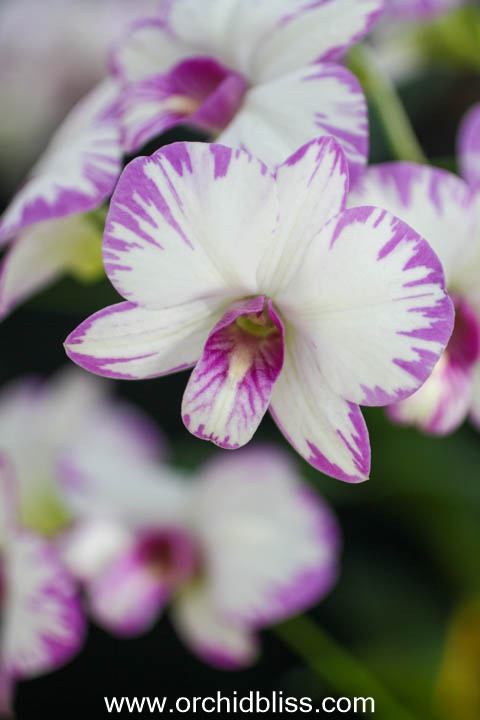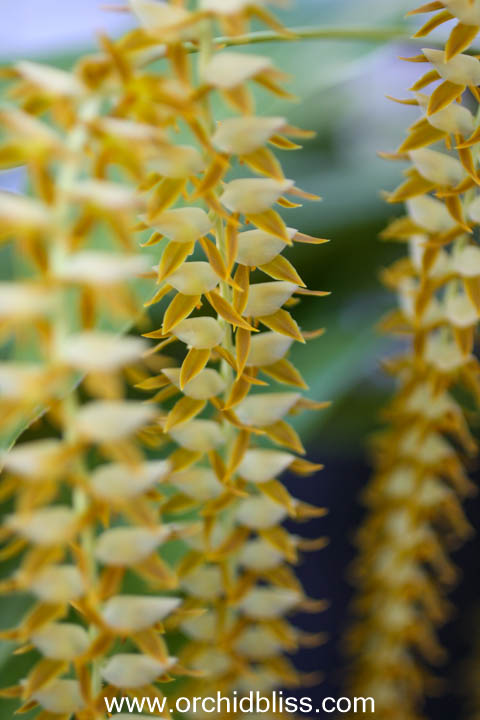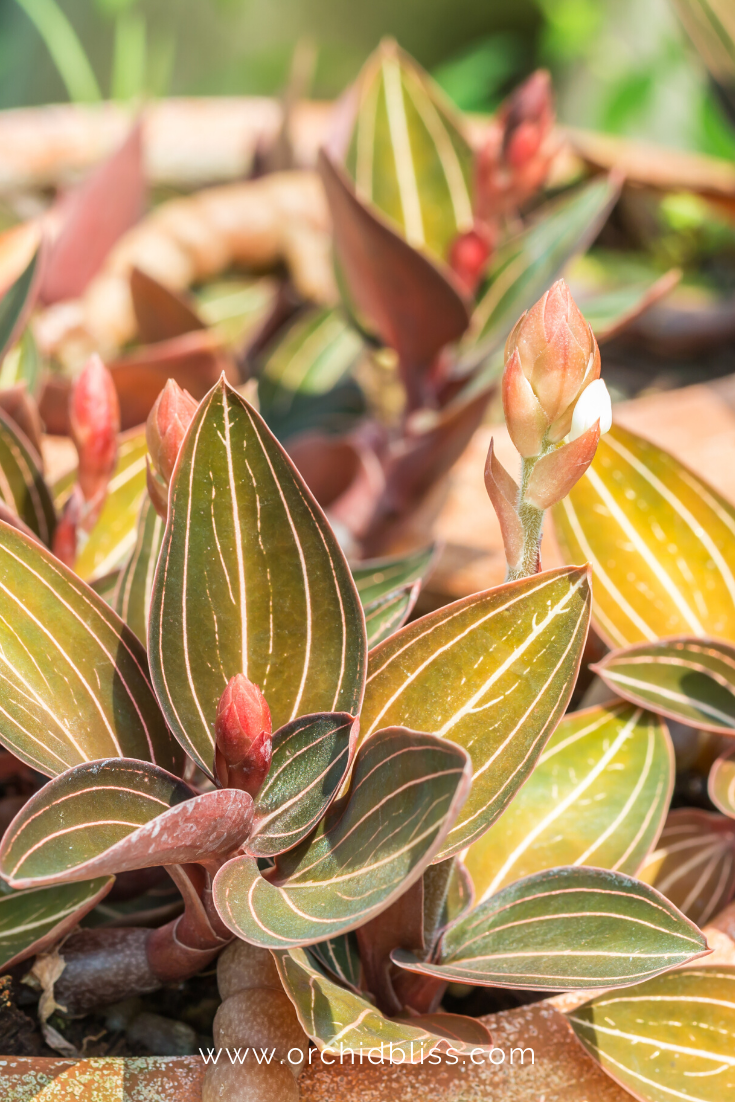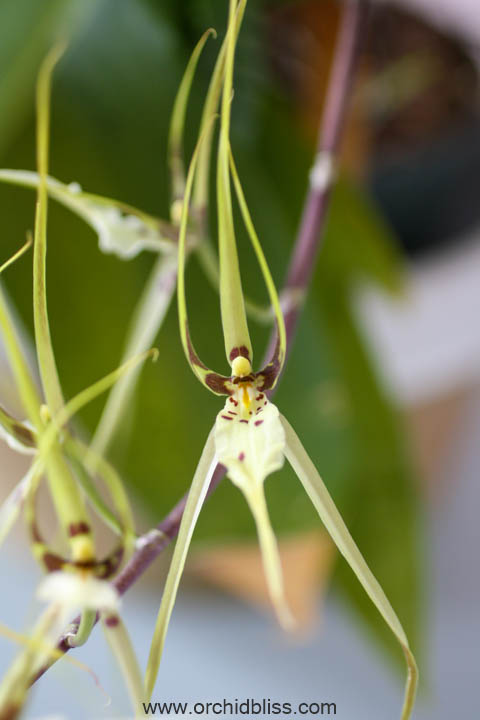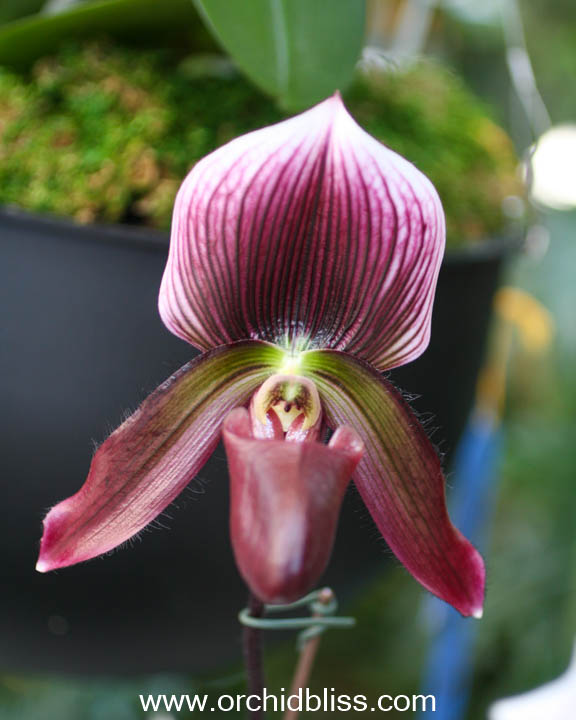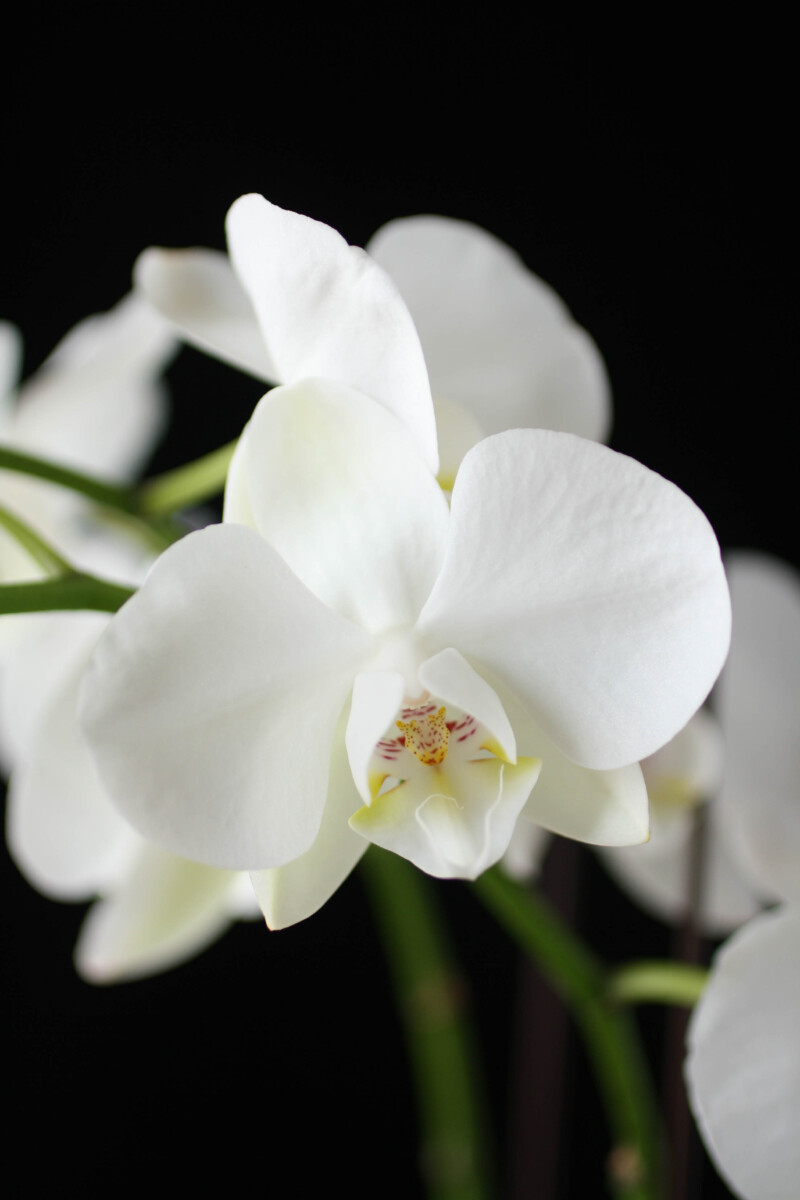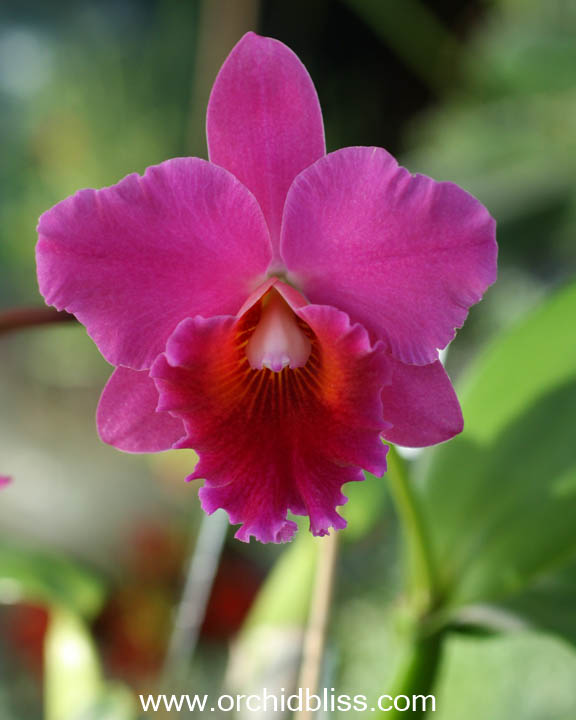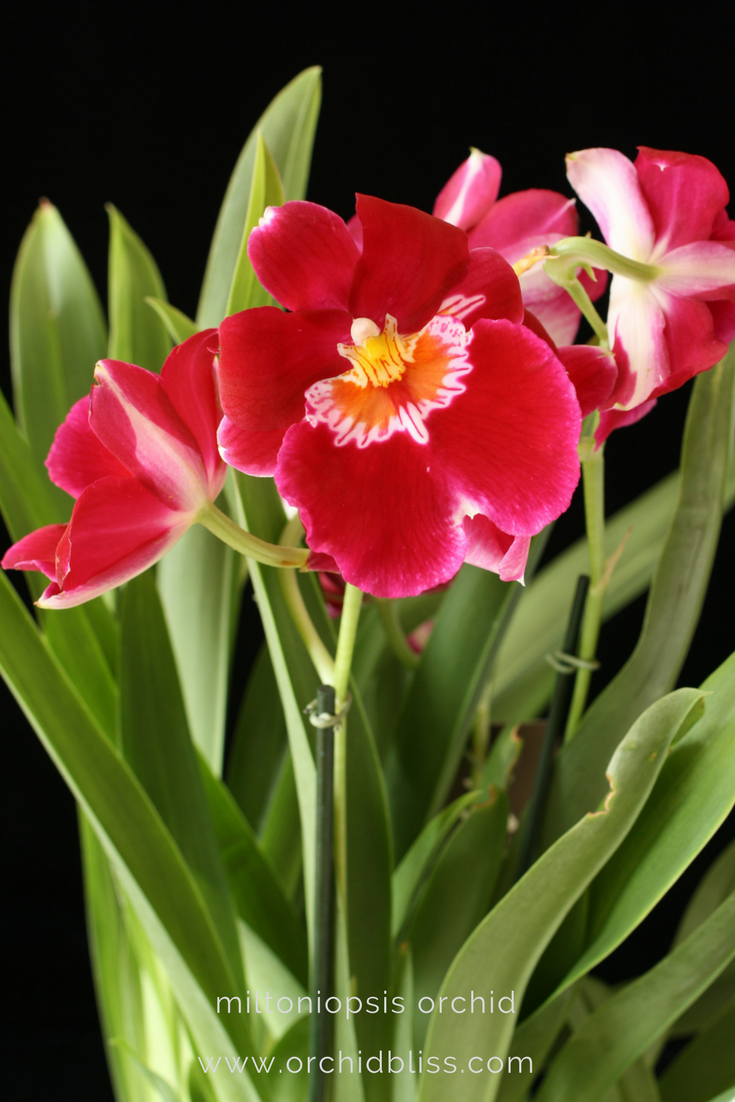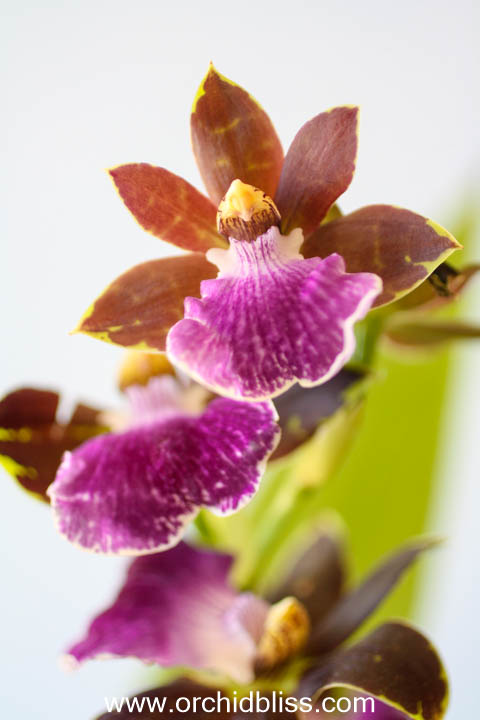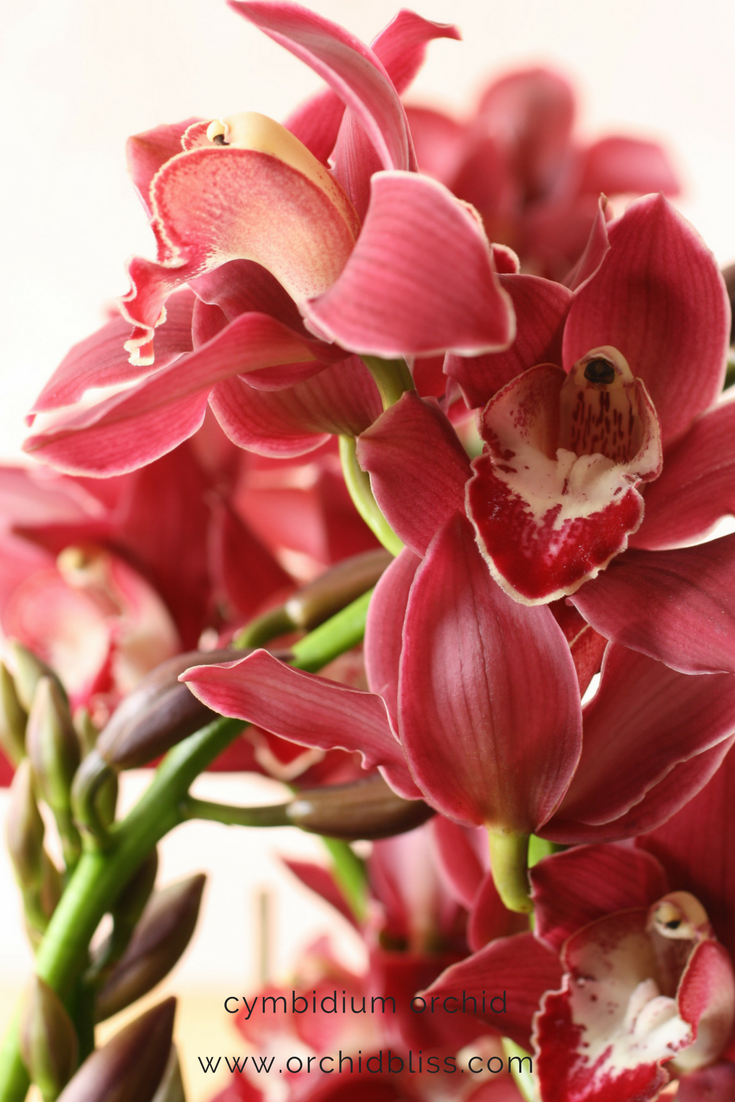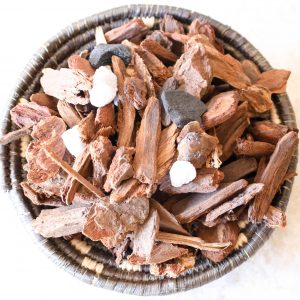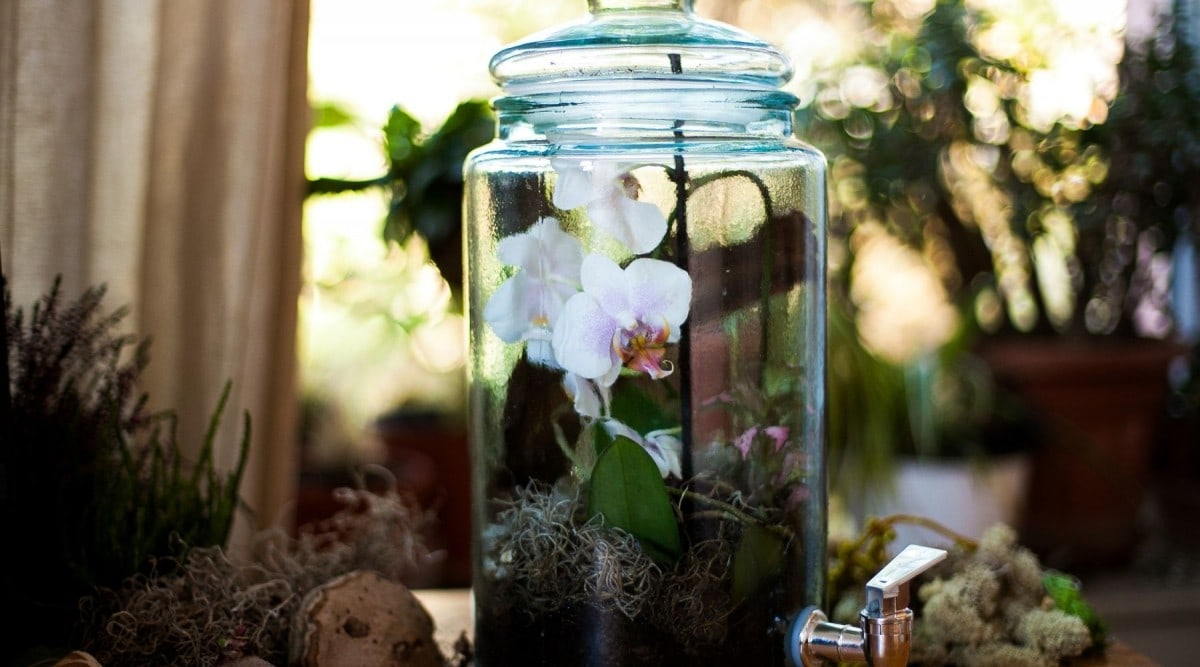
Orchids thrive and bloom when given specific temperature conditions and light requirements. While this atmosphere can be challenging to create, one way to easily control and maintain this environment is to grow orchids in a terrarium.
To create an orchid terrarium, select the best type of plants, substrate, and experiment to maintain the best environmental conditions to help it thrive and bloom. Creating one allows you to control the temperature, light, humidity, and airflow to cultivate the best atmosphere for your orchid.
Throughout the rest of this article, you will also learn the following information about how to create an orchid terrarium:
- How to choose the best orchid variety depending on your terrarium
- Setting up and placing your terrarium
- Adjusting for light, temperature, airflow, and humidity
- Tips and warnings for your orchid terrarium
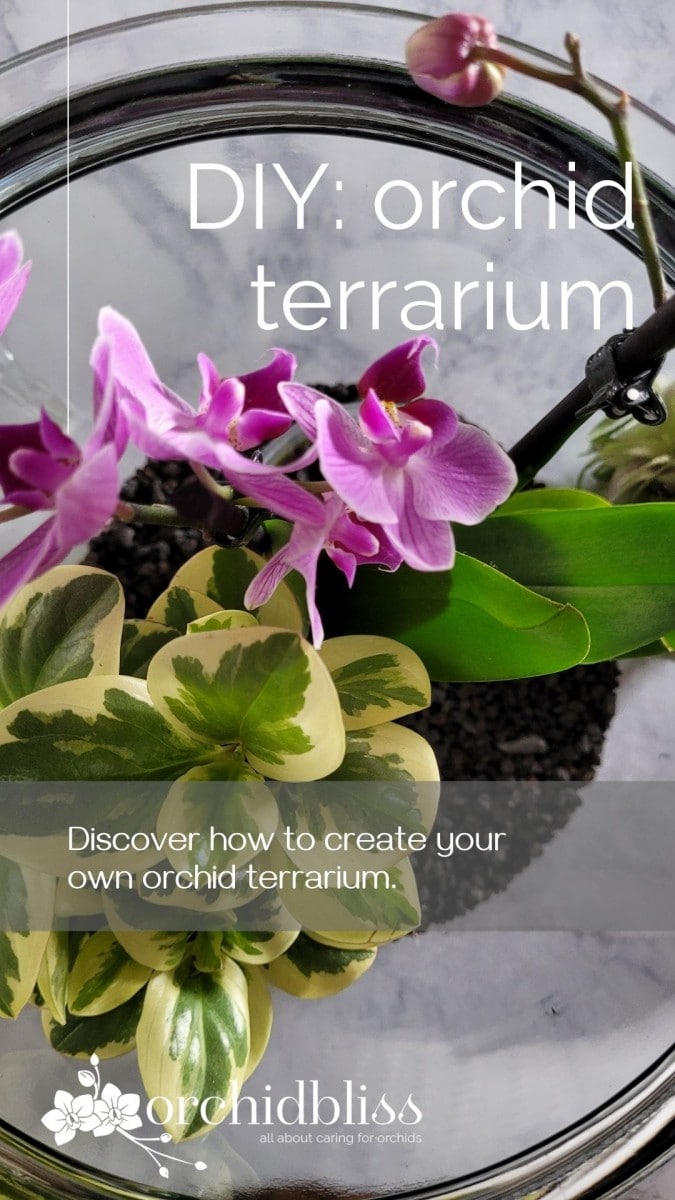
Some of the links on this page may be affiliate links. Click here to learn more.
Why Create an Orchid Terrarium?
Rather than changing your entire room’s environment to suit your orchids, it can be easier to contain the plant in an enclosed and controlled terrarium. You can control essential factors such as temperature, light, humidity, and airflow and easily alter various factors to impact your plants.
Additionally, creating an orchid terrarium allows you to build a scene to showcase your orchid. When your orchid is not in bloom, you can often fill the terrarium with other filler or companion plants along with props or mini sculptures to decorate your terrarium.
While you might have seen pictures on social media of closed orchid terrariums, usually, orchid plants do not grow well in these environments. If you plan on adding a fan to circulate airflow and a large aquarium tank, then you will see your orchid plant thrive. Still, generally, orchids do not live in small enclosed environments for long without suitable airflow. To provide adequate air movement, creating an open terrarium is often the best option for orchids.
Most orchid plant varieties come from tropical and humid climates, but airflow is very high in those environments and often dry out the orchid roots before night. In a closed terrarium, the roots of the orchid will not have a chance to dry out. Orchid plants need humidity, but the roots will rot without air, and the stem will slowly decay over time.
1- Choose Your Plants
Several orchid varieties work well in a terrarium that can handle humidity and are sized appropriately for your terrarium. The orchid should handle low to medium levels of light and handle moderate temperatures. By grouping plants with growing conditions similar to each other, your terrarium will last and live for a more extended time.
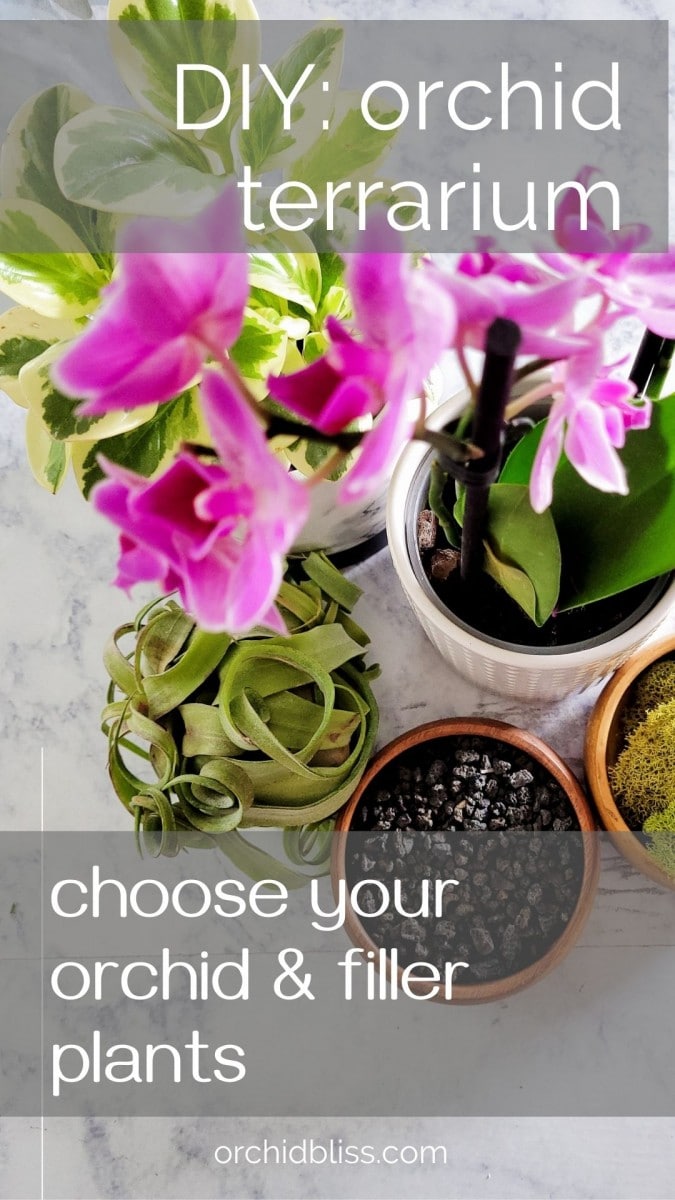
The Orchids
- The Paphiopedilum orchid often called the lady slipper orchid
- The miniature Phalaenopsis, commonly called moth orchids
- The Masdevallia orchid is found in Mexico to southern parts of Brazil, and various high-altitude regions in South America
- The Pleurothallids orchids, a large variety of orchid plants from the tropics of the Americas
- Jewel orchids are commonly referred to as orchids that are grown for the leaves rather than flowers
- Miniature Angraecum orchid species and hybrids, one of the first that is described of the African orchids and range from a couple of inches tall to over 6 feet (approximately 183 centimeters) high
Several orchids work well and thrive in a closed terrarium with high humidity. These orchid varieties are:
- The Masdevallia orchid, a plant that thrives in humidity at a minimum of 80 to 100 percent, makes them the perfect choice to grow in a closed terrarium. Because this variety is in the low-light category, ensure that your terrarium is not placed in direct sunlight.
- The Dracula orchid, also commonly known as the monkey orchid, is named from the Latin word “dragon” rather than the classic horror vampire. This orchid variety prefers a temperature range from a minimum of 58º F (14º C) to a maximum of 68ºF (20º C).
- The Lepanthes orchid blooms one flower at a time, and the flowers are very small at about 0.3 inches (about 8 millimeters). Since this variety prefers full shade, place this orchid plant in your terrarium in the back or underneath a prop as a filler plant.
- The Platystele orchid blooms bunches of tiny flowers at 0.1 inches (about 2.5 millimeters).
- The Tolumnia orchids bloom beautiful flowers, and once they blossom, they often bloom again so you can see two blooms right after each other. However, this variety is tough to grow in a terrarium, and its roots rot very quickly. Try to avoid misting them and always check their roots for any rot.
Other orchids may grow too big for your terrarium, but you can always check with your supplier and use them instead if you are interested in growing other orchid species. Whichever variety of orchids you end up choosing, make sure to do your research and select plants that prefer similar climates, so your terrarium does not require different environments, which is more complicated with a higher chance of failure.
Filler Plants
Choose appropriately sized filler plants that can handle humidity if you plan on having plants to compliment your orchid terrarium. It would be best if you chose plants that grow slowly or remain very short in stature.
There are several varieties you can include, such as:
- Small ferns
- Fibrous rooted begonias
- Small ferns
- Rhoeo
- Short crotons
- Small dracaenas
- Selaginella
- Peperomia
- Short nephthytis
Beyond filler plants, you can also add some companion plants to your orchid terrarium. Some of these companion plants naturally occur with orchids and can bloom to produce flowers or can be arranged to give the terrarium a more jungle-like appearance.
Several suggestions for companion plants include:
- Tillandsia, commonly known as air plants
- Cryptanthus, varied plants ranging from dark green to red and bright pink
- Spanish moss, rather than moss, this plant is actually an air plant
Adding these filler or companion plants will make the terrarium look more attractive as some of these plants can add color when your orchid is not in bloom. However, try to keep the colored plants to a minimum as the orchid terrarium will look less natural and too busy.
The advantages of setting up an orchid terrarium are that you can create a contained environment with specific atmospheric conditions rather than merely growing the plant on a windowsill. While the setup is more complicated, once the terrarium is up and running, it will be much easier to maintain.
There are several steps to consider when preparing and setting up your orchid terrarium, these are:
- Cleaning and sterilizing
- Choosing the substrate
- Adding props
- Controlling the airflow and humidity levels
- Adjusting for light and temperature
- Watering and fertilizing
2- Clean and Sterilize
If you have an old aquarium tank that you plan to use for your terrarium, you will need to scrub it with soap and rinse it thoroughly with water. If it is a fresh-water tank, then you can use mild dishwashing soap. If it is a salt-water tank, you may have to use the dishwashing soap to rinse it out, let the tank sit in water for a couple of days, and then repeat the scrubbing several times over multiple days to ensure it is spotless.
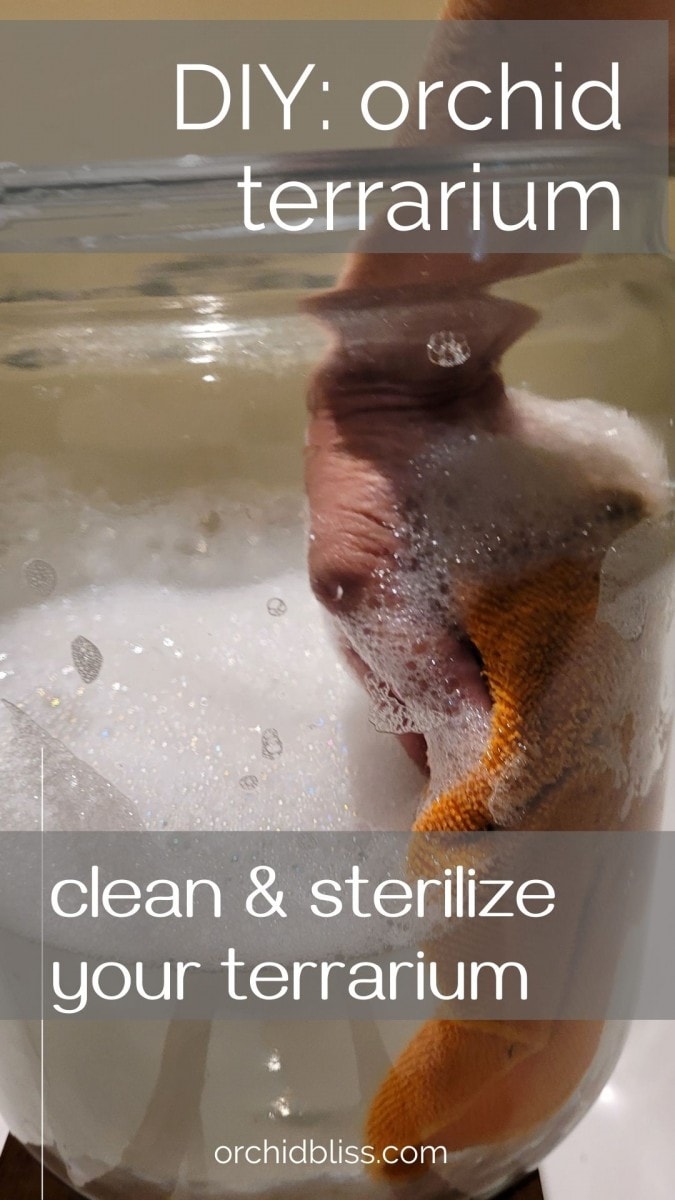
The multiple washes are because any salt that remains in the tank will potentially interfere with the terrarium and cause issues. Ensuring the tank is thoroughly cleaned will avoid potential headaches because disease spreads quickly in enclosed environments and will destroy your plants.
If you are using a used terrarium, you should wash it several times to let it dry completely in between each rinse. Take an additional step to rinse with a diluted bleach solution to remove harmful bacteria to prevent your plants from getting any disease.
It is widely recommended to use one tablespoon (15 milliliters) of household chlorine bleach for 1 gallon (3.79 liters) of water will remove any mold, fungus, or potential disease that may be leftover from plants previously planted in your terrarium.
While cleaning and rinsing with water, you should also test it to make sure it is completely waterproof. Preparing your terrarium is key to a healthy environment, so do not skimp out on ensuring the tank is clean.
3- Choose the Substrate
Your first instinct might be to fill up the bottom layer with sand, soil, or gravel as the substrate for your orchid terrarium. However, these materials can easily cause issues with the terrarium’s environment, introduce disease to the terrarium, and are difficult to remove and clean. Orchid terrarium enthusiasts highly recommend using an egg-shell crate as the material for the base layer and then building on top.
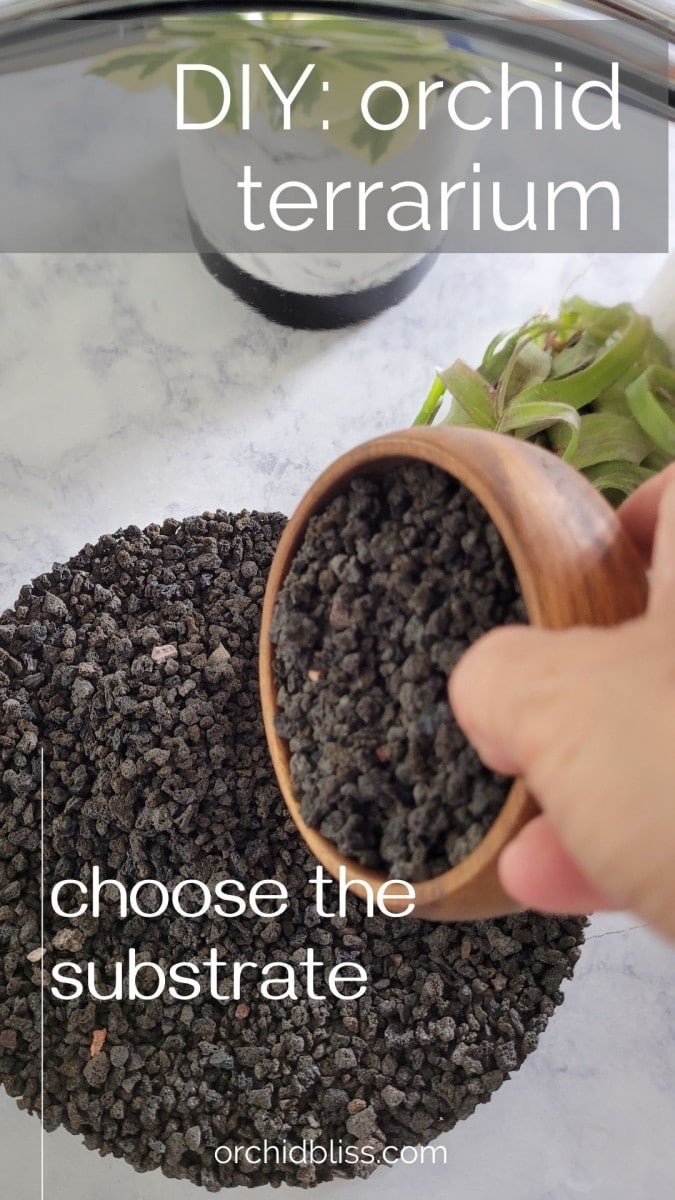
Using an eggshell crate will keep the plants above the water that can accumulate on the bottom of the tank and can be easily removed if you need to do any maintenance or start a new terrarium. Egg-shell crates can be found in Home Depot or any home development department store and are the material used for fluorescent light fixture coverings. It is easy to cut and shape to line your terrarium.
You can also use a layer of small stones approximately 2 inches (about 5 centimeters) high at the bottom. You must wash the stones first before placing them in the terrarium- rinse them with soap or the diluted bleach solution and let them dry thoroughly.
To help you even further, grab your free cheat sheet for strategies you can use right now to prevent limp leaves and rotten roots. Click here to grab your cheat sheet to learn how to grow healthier orchids. It will be super helpful.
4- Place and Add Props
In the orchid terrarium, you should position and place moss around them to cover the orchid pots to make the terrarium look more natural without the pots being visible. You can set other props such as cork, driftwood, or moss to cover up the pots. While you can purchase driftwood from an aquarium store, you can also collect props from the outdoors for free but always clean all items properly before placing them in the tank.
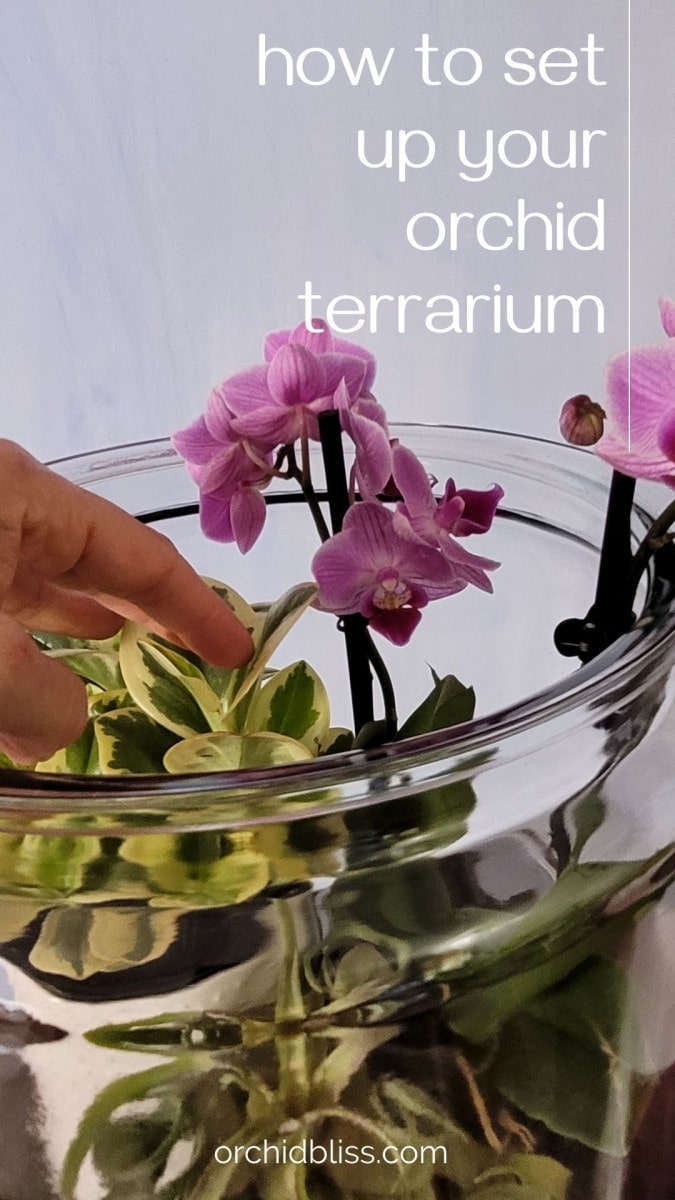
After placing the substrate and adding the props, place your filler and companion plants to frame your orchids by placing the larger plants behind the orchid and the shorter ones towards the front of your terrarium. Make sure that your orchids are not crowded by your filler plants, as the orchids should be your focal point. Always inspect all the filler and companion plants to avoid introducing any diseases or pests to your terrarium.
Regardless of what substrate you ultimately use, keep your orchids in their pots. Initially, the terrarium might look a little out of place with the placements looking a bit awkward, but allow the plants to start to grow, and it will all come together within a couple of months!
Note: You might want to plant the orchids directly in the terrarium rather than keeping them planted in pots. If you do, then you will run into the potential risk of the plant dying. Orchids need their roots exposed to air, and growing them will not let them receive adequate airflow.
5- Control Airflow and Humidity
Installing a small fan will help keep air moving in the terrarium to prevent air from becoming stagnant. You can buy specialty fans or modify a computer fan and place it at the top or at the back of the terrarium. While in smaller terrarium tanks, airflow is usually not an issue, larger terrarium tanks will require airflow to provide gentle air to move inside the tank. Air circulation is vital to the longevity of your orchid plant.
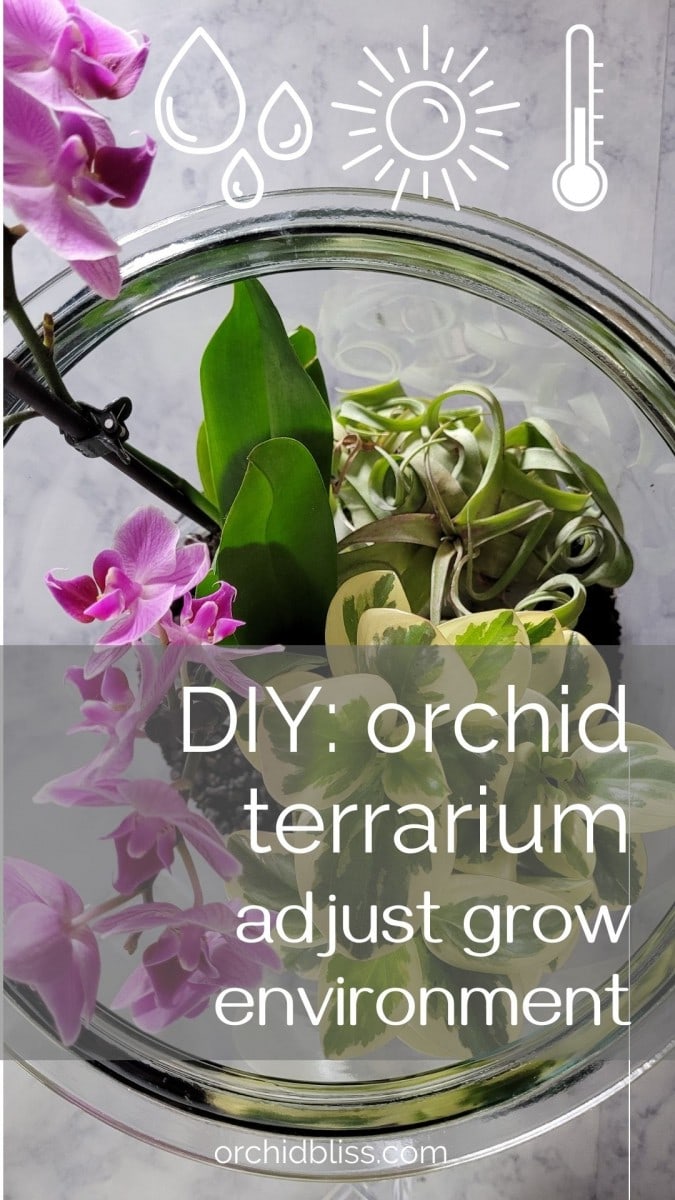
If the terrarium’s environment is humid, but the air is stagnant with no airflow, then the atmosphere can promote the growth of bacteria. In the case of inadequate air circulation and a lot of humidity, your orchid will accumulate toxic gas, which causes root rot. If your orchid cannot dry out its roots, then carbon dioxide will rise as gas becomes trapped inside the plant’s roots.
To avoid suffocation, the plant will release phenols to neutralize these toxins that are harming the roots but will turn the roots brown/black, which we note as root rot. Additionally, since carbon dioxide is not being released into the air of the terrarium, it will instead form carbonic acid with water that will eventually decompose the orchid roots and the substrate or potting material.
In the case of low humidity, your orchid will show signs of wrinkling, crusty, or crunchy leaves. You can install a humidity gauge in your terrarium to track readings.
The following are some percentages of relative humidity for orchid varieties that have been recommended previously in this guide:
- Phalaenopsis: 50%
- Lepanthe: 80%
- Masdevallia: 60 – 80%
- Paphiopedilum: 40 – 50%
6- Adjust Light and Temperature
The correct temperature is essential for your orchid to bloom. If you do not get a fluctuation of temperature at night, then your orchid will most likely not bloom. All orchids require at least 10° F (-12.22° C) to 15° F (-9.44° C) drop from their initial temperature at night to remove heat from their leaves. If your orchid grows in the same environment throughout the entire year without any changes, then your orchid will start to display signs of heat stress.
Other orchid varieties will have difficulty growing if the temperatures at night are too cold for the plant to handle. In this situation, flowers will wilt, and you will see the orchid’s leaves blacken on the tips. While you might mistake them for naturally occurring aging leaves because when leaves die off, they start to darken, the blackened leaves may also be due to the temperature.
Generally, orchids have three different categories for preferential temperatures. These categories are:
Warm Growing Orchids | Warm-Intermediate Growing Orchids | Intermediate Growing Orchids | Cool Growing Orchids |
Dendrobium phalaenopsis Dendrochilium Ludisia - Jewel | Brassia Paphiopedilum - Slipper Phalaenopsis | Cattleya Miltoniopsis Zygopetalum | Standard Cymbidiums
|
- Warm growing orchids: Prefer temperatures from 64º F (18º C) to 90º F (32º C).
- Intermediate growing orchids: Prefer temperatures from 55º F (13º C) to 86ºF (30º C).
- Cool growing orchids: Prefer temperatures from 50ºF (10º C) to 75º F (24º C).
Deciding on the Location of the Terrarium
Making sure to place your terrarium in a perfect location is crucial for your terrarium’s longevity. For example, suppose you are having trouble thinking of where to place your terrarium. In that case, orchids that grow in warmer conditions can be kept in the kitchen, and orchids that grow in intermediate conditions can be placed in your living room.
You should select a location for your orchid terrarium where it is not directly in sunlight because the glass will result in higher heat, and the enclosure will act more like an oven. In bright direct sunlight, the orchid leaves can burn, resulting in damaged plants.
If you plan to keep the terrarium near a window, leave at least approximately 1 inch (about 2.5 centimeters) to a few feet (about 1 meter) depending on where you are located between the window, so the tank is not affected by any changes in outdoor temperatures.
If the terrarium touches the window, but the outdoor weather is cold, then the terrarium’s environment can be influenced by lower temperatures, which can damage your plants. Additionally, remember to move your orchid terrarium around as light can change with the seasons.
Orchid Light Requirements
If your location does not have ample light, you can place bulbs at the top of the terrarium to produce some light in replacement for sunlight. Additionally, you may want to consider installing some reflective background to provide additional light to hit the tank.
Incandescent tubes often produce too much heat for your terrarium to handle, and opting to use these bulbs will require venting to dissipate the heat. If you install bulbs, then there is a simple trick to check if the light is too strong.
Put one of your hands in front of the light beaming onto the orchid plant, about 6 inches (about 15.2 centimeters) above the leaf. If you can trace the shadow of your hand, then the light is too strong. If your hand’s shadow is too blurry and cannot be traced, then the light is too weak. As long as your shadow is slightly diffused and not as sharp but still somewhat traceable, then that is the ideal amount of light for your plant.
Make sure to maintain the bulbs by wiping them down about once a month to remove any dust build-up over time. While it can be challenging to see, a thin layer can interfere with how much light is emitting from the bulb, which affects the amount of light that your orchid terrarium receives.
There are three distinct categories of orchids when classifying light requirements for each type. Some orchids prefer dimmer shade while other plant varieties like bright light sources. Orchid plants can be categorized as the following:
- High-light growing orchids: Prefer 3,000 FC or about 32,291.73 lux
- Medium-light growing orchids: Prefer a range from 2,000 to 3,000 fc or about 21,528 to 32,292 lux
- Low-light growing orchids: Prefer a range from 1,200 to 2,000 fc or about 12,9167 to 21,528 lux
These categories are described by foot-candle (FC), a description of one lumen per square foot, or lux, which is defined as a single lumen for each square meter. Some orchid suppliers will provide foot-candle requirements, but lighting supplies usually market their product with lumens or lux. So it is good to keep these measurements in mind to ensure you purchase the proper lighting depending on your orchid’s needs.
You can opt to place a thermometer and check the temperature to ensure your plants do not bake in the terrarium. The temperature within the terrarium should not reach above 80° F or 27° C during the day because glass retains heat. Since different orchid plants have additional temperature requirements, ask your plant supplier to see what temperature would be best for your terrarium. I recommend using a humidistat because they give readings for both temperature and humidity.
Note: It can help to place a thermometer inside an empty tank for a couple of days to track temperatures at various times during the day and night. You will be able to figure out the range of temperatures and potentially avoid needing to relocate your orchid terrarium once it is set up.
Observe Your Orchid
If... | Then... |
the leaves are deep dark green | your orchid may need more light |
the leaves are spotting | the temperature may be getting too hot |
the orchid is turning slightly pink or red on the outer leaves | the temperature is too low for the orchid or requires some fertilizer |
the orchid leaves turn yellow or yellowish-green | they may have too much sun and need to be relocated further away from the light source |
Observe the leaves from your orchid. If the leaves are deep dark green in color, almost leaning towards the color of spinach, then your orchid plant may need more light. If the leaves are spotting, then the temperature might be getting too hot for the plant. If the orchid is turning slightly pink or red on the outer leaves, it could mean that the temperature is too low for the orchid or requires some fertilizer.
If the orchid leaves turn yellow or yellowish-green, they have too much sun and need to be relocated further away from the light source. Sometimes there are orchid varieties that are marketed and sold as high-light growing orchid plants but cannot tolerate as much sun as they are supposed to, so do your research to learn how to care for your plant correctly.
7- Water and Fertilizing
Since there is no easy way to remove the salt that has accumulated from the terrarium, use rain or distilled water to mist your terrarium to avoid any risk of salt or mineral residue in the controlled environment. Water increases the humidity, and orchid plants usually prefer humidity at 80 to 100 percent.
Watering for Egg Crate or Soil Substrate
You should mist with water approximately every four days if you are using soil or egg crates as your substrate. The amount of watering would depend on the amount of venting, especially if you installed a fan to ensure your terrarium does not dry out. Mist more often to provide proper moisture and humidity levels in your terrarium. To help prevent bacterial spotting and infection, always mist the orchid roots, rather than the leaves or flowers.
Watering for Rock Substrate
If you used rocks as the substrate for the bottom of your terrarium, fill the terrarium with 1 inch (about 2 centimeters) of water. Avoid the water from reaching the bottom portion of the orchid pots because if the orchid roots sit in water, the roots can rot and die.
You can water the orchids by removing the orchid plants and placing their pots in a tub filled with distilled water at room temperature for approximately 30 minutes. Swirl the distilled water right before putting the orchids to add oxygen, and then let the orchids drain for 30 minutes before placing them back in the terrarium. It would be best if you watered them approximately once a week.
You might need only to give them one spoonful of distilled water a week for smaller orchid terrariums. You can revive under-watered orchid plants as they can be saved, but orchid plants that are overwatered can quickly die. While you might need to mist the plants more often (2-3 days rather than four days), you will need to assess the humidity levels and ensure that it is not drying out.
Fertilizing
It is recommended to fertilize at a significantly reduced concentration and not more than once a month. The limited amount of fertilizer is to avoid a build-up of salt, so about one-eighth or 12.5 percent of the recommended dosage prescribed on the fertilizer’s label would work best. Use a fertilizer specially developed for orchids for the best result.
Conclusion
Many orchids are delicate and only blossom at specific temperatures and humidity levels. One way to control and monitor the environment is to create an orchid terrarium. While constructing the ideal environment takes a bit of experimentation, your orchids will thrive with minimal care once it is set up.
If you’d rather buy an orchid terrarium than make one, click here. There are super cute ones on Etsy!
To help you further, start by downloading my free cheat sheet to see where to cut the orchid flower spike after the blooms have faded to trigger re-blooming. Click here, for the cheat sheet. It’ll be super helpful.
Sources
- Wikipedia: Phalaenopsis
- Wikipedia: Paphiopedilum
- Wikipedia: Masdevallia
- New World Orchids: The Pleurothallids
- Wikipedia: Jewel Orchid
- American Orchid Society: Angraecum
- Wikipedia: Tillandsia
- The Spruce: Cryptanthus
- Orchid Plant Care Info: How to Grow Orchids in a Terrarium
- Clouds Orchids: Terrariums – Introduction
- Garden Guides: How to Grow Orchids in a Terrarium
- HousePlant 411: How to Make an Orchid Terrarium
- Home Beautiful: How to make an Orchid Terrarium
- Orchideria: 5 Best Orchids for Closed Terrariums
- Orchideria: Orchid Temperatures
- Orchideria: Managing Humidity
- Orchideria: Orchid Light Requirement
- Wikipedia: Foot-candle
- Orchideria: Orchid Light Requirements

